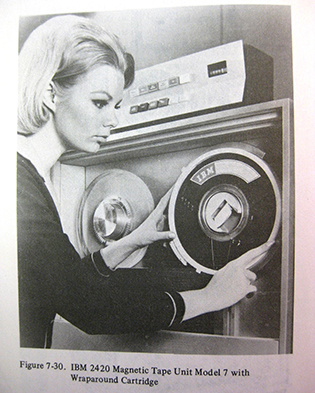From the Annals of NIH History: Computers
The IBM 370: Computers a Gogo

This computer technician appeared in the IBM 370 Systems Manual in 1975. NIH used IBM 370s, which were mainframe computers, from 1971 until the mid-1990s, along with DEC System 10 mainframes, to store and process scientific and personnel data. In 1976, the National Library of Medicine (NLM) got its own IBM 370, which it used for updating master records, controlling inventory, and quickly processing overdue notices. NLM staff had to affix labels to its 80,000 volumes one by one, a daunting task. By 1984, NIH had five IBM 370 Model 3081 computers, 115 magnetic-tape drives, 344 disk drives, two mass-storage systems, 11 high-speed printers, dozens of card readers and card punches, and countless microfiche output units. The system also had over 1,200 telephone lines serving hundreds of remote terminals at NIH and other federal agencies.
Today, the NIH Center for Information Technology (CIT) handles the many kinds of computer interactions required by a biomedical research campus. CIT’s responsibilities have expanded significantly with the development of desktop and mobile computer technology. They include managing networking infrastructure management; voice and video messaging; identity and access management (cybersecurity); storage services; and customer-support services. The NIH High-Performance Computing Core Facility replaces much of what the IBM 370 systems did by providing computing systems specifically for the intramural NIH community. These systems include Biowulf, a 20,000+ processor Linux cluster; Helix, an interactive system for short jobs; Sciware, a set of applications for desktops; and Helixweb, which provides web-based scientific tools.
This page was last updated on Wednesday, April 13, 2022
